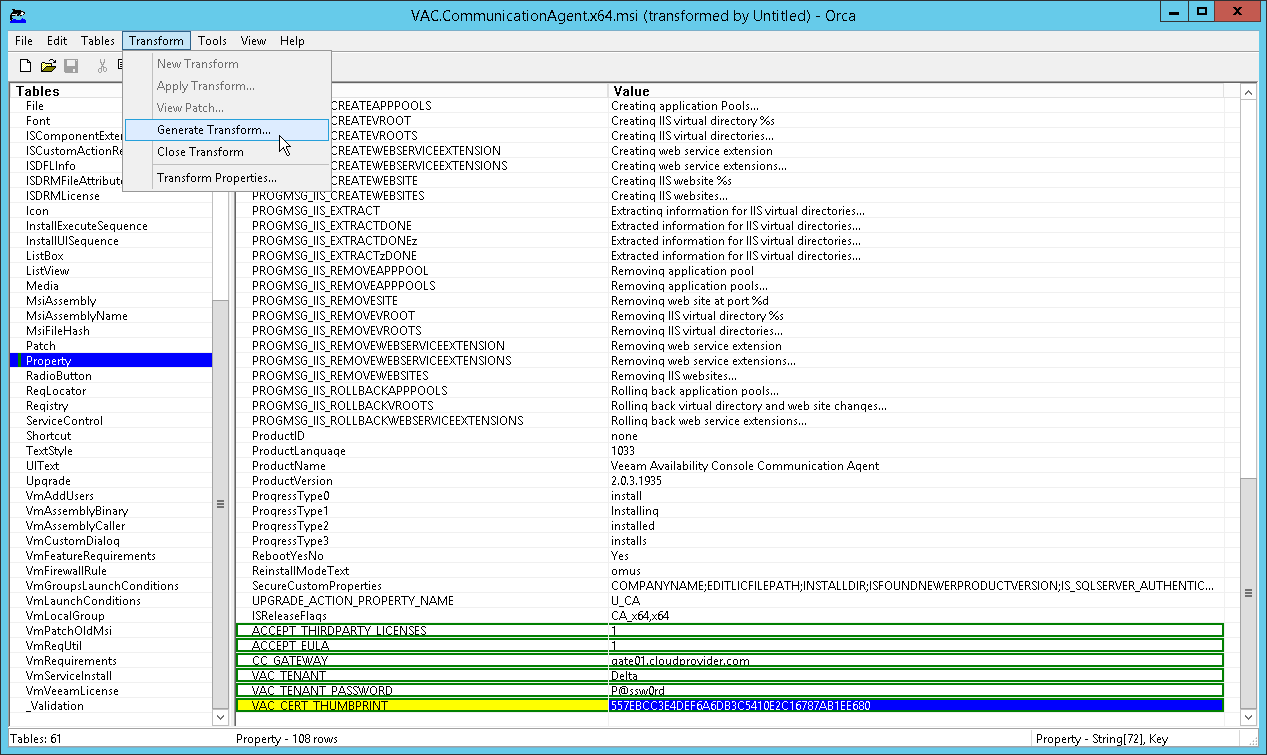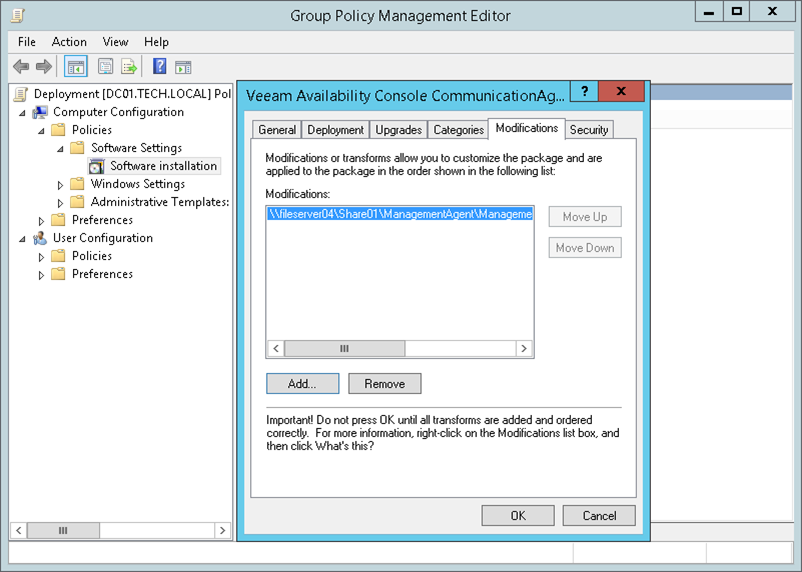 This is an archive version of the document. To get the most up-to-date information, see the current version.
This is an archive version of the document. To get the most up-to-date information, see the current version.Step 1. Deploy Management Agents Using Group Policy
You must create an MST file with custom configuration parameters and use this MST file to deploy the Veeam Availability Console management agents on client computers. The management agents will use parameters specified in the MST file to connect to a cloud gateway on the service provider side.
Step 1.1. Unpack Management Agent Setup Files
Unpack the content of the management agent setup file:
- Obtain the necessary version of the Veeam Availability Console management agent setup file.
The management agent setup files reside in the C:\Program Files\Veeam\Availability Console\ApplicationServer\AgentPackage folder on the machine where Veeam Availability Console is installed. If you installed Veeam Availability Console using a distributed installation scenario, check this folder on a machine where the Veeam Availability Console Server component runs.
- Perform installation of the management agent in the administrator mode to unpack the content of the setup file:
- In the command prompt, run a command to start the Veeam Availability Console Communication Agent wizard.
For example, for the 64-bit version of the management agent, the command must be:
msiexec /a VAC.CommunicationAgent.x64.msi
- At the Network Location step of the wizard, specify a directory to which setup files must be unpacked.
- Click Install.
- Check the output directory and make sure it includes the following items:
- Setup file VAC.CommunicationAgent.x<bit>.msi
- Folder RealProgramFiles
- Copy the unpacked files to a network share.
The network share must be accessible from all client computers on which you want to deploy the management agent.
Make sure you set at least Read permissions on the files.
Step 1.2. Create MST Configuration File
Create an MST configuration file with installation parameters that point to the necessary cloud gateway:
- In the directory with unpacked setup files, locate the management agent setup file and open it for edit with Orca.
For details on Orca, see Windows Dev Center.
- In the menu, choose Transform > New Transform.
- In the Tables pane, click Property.
- Add the following properties to the table:
- ACCEPT_THIRDPARTY_LICENSES — specifies if you want to accept the terms of the license agreement for the 3rd party components.
Specify 1 if you want to accept the terms and proceed with installation.
- ACCEPT_EULA — specifies if you want to accept the terms of the Veeam license agreement.
Specify 1 if you want to accept the terms and proceed with installation.
- CC_GATEWAY — FQDN or IP address of a cloud gateway.
- VAC_TENANT — user name for connecting to the service provider.
- VAC_TENANT_PASSWORD — password for connecting to the service provider.
You must specify credentials of the Company Owner. These credentials are defined when a company account is created. For details, see Creating Companies.
- VAC_CERT_THUMBPRINT — thumbprint of a certificate that is installed on the Veeam Availability Console server, and used to secure traffic between the service provider and clients.
The thumbprint is used to verify the authenticity of the certificate. Although this property is optional, it is recommended that you specify it.
- If you have changed the default port number when deploying the cloud gateway, locate the CC_GATEWAY_PORT property and change the port value.
For details on the gateway port configuration, see Adding Cloud Gateways.
- In the menu, choose Transform > Generate Transform.
- Save the MST file with configuration details.
- Close Orca.
- Copy the MST to a network share.
The network share must be accessible from all client computers on which you want to deploy the management agent.
Make sure you set at least Read permissions on the file.
Step 1.3. Create Group Policies
Create a Group Policy that will install and configure the management agent on client computers:
- Log on to a domain controller.
- Open the Group Policy Management Console.
- Right-click the OU which includes computers on which management agents must be deployed, and choose to create a new Group Policy Object.
- Right-click the Group Policy Object and choose Edit.
- In the left pane of the Group Policy Management Editor, expand Computer Configuration > Policies > Software Settings.
- Right-click Software Installation and select New > Package.
- In the Open window, point to the management agent setup file located on the network share.
This must be the setup file obtained as a result of installation in the administrator mode, as described at Step 1.1.
- In the Deploy Software window, choose the Advanced deployment method.
- Open the Modifications tab, click Add and choose the MST file located on the network share.
- Click OK.
- In the left pane of the Group Policy Management Editor, expand Computer Configuration > Policies > Administrative Templates > System > Logon.
- Right-click the Always wait for the network at computer startup and logon policy setting and choose Edit.
- In the policy setting window, select Enabled and click OK.
- Close the Group Policy Management Editor.
Step 1.4. Apply Group Policies to Client Computers
Apply the created Group Policy to client computers.


